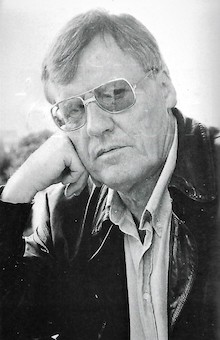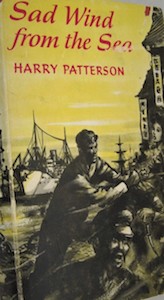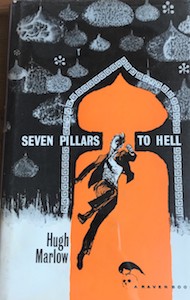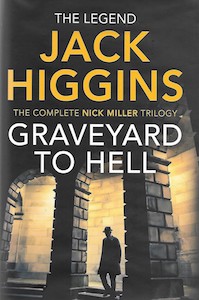 There can be few thriller readers who have not at least heard of The Eagle Has Landed, very few of a certain age who have not read it, and hardly anyone with a television who has not seen the film version. For many who remember its publication in 1975, it marked the arrival on the international bestselling thriller scene of a certain Jack Higgins, but it was by no means the author’s debut. It was in fact his 36th published novel and his name wasn’t really Jack Higgins, it was Henry (known as Harry) Patterson, but it was also Martin Fallon, James Graham and Hugh Marlow.
There can be few thriller readers who have not at least heard of The Eagle Has Landed, very few of a certain age who have not read it, and hardly anyone with a television who has not seen the film version. For many who remember its publication in 1975, it marked the arrival on the international bestselling thriller scene of a certain Jack Higgins, but it was by no means the author’s debut. It was in fact his 36th published novel and his name wasn’t really Jack Higgins, it was Henry (known as Harry) Patterson, but it was also Martin Fallon, James Graham and Hugh Marlow.
Technically, it was Harry Patterson who died last week, aged 92, following a stroke, but the obituary writers and memorialists will not be able to resist the name Jack Higgins and I do not think the author would have minded, as it was a pen-name which had served him supremely well for more than half a century.
Harry Patterson was born in Newcastle in 1929 but before the age of two his parents separated and he was taken by his mother to Belfast to spend his childhood as part of her extended family in the Shankhill area where he attended Nettlefield elementary school (as did George Best some twenty years later). Aged ten and with war looming, he was relocated to Leeds where his mother remarried. After National Service in the Household Cavalry serving on the border with East Germany, he trained as a teacher and studied for an external degree in Sociology from the L.S.E. As a young man in Leeds, he joined in the Bohemian life of the city, befriending the unknown actor Peter O’Toole and the debutant novelist John Braine. He also met literary agent Paul Scott who placed Patterson’s first novel Sad Wind From The Sea, a treasure-hunt adventure set in South China seas he had never visited, for an advance of £75 in 1959.

Patterson was 29 and well-and-truly bitten by the writing bug. Thrillers, crime novels and spy stories flowed effortlessly under a clutch of pen-names over the next decade and his fan base grew, albeit in the shadow of other thriller writers such as Alistair Maclean, Hammond Innes, Desmond Bagley and Geoffrey Jenkins. “I had done alright,” Patterson was to say, “but I hadn’t done brilliantly.”
His plots were never less than inventive, such as in the 1963 adventure Seven Pillars To Hell (later reissued as Sheba) which begins with an elaborate Nazi scheme to sabotage the Suez canal on the outbreak of WWII but which declines into something of a sub-Indiana Jones tale, but frantic action always predominated rather than plot twists or character development. Even when he created two credible series heroes, in the spy Paul Chavasse (six books) and the police detective in a grim northern town, Nick Miller (three), Patterson seemed to be always anxious to get on to the next idea.

The early 1970s saw more attention to character in his writing, solid commercial success and even some glowing reviews. His war story A Game For Heroes, published in 1970 by Macmillan under the name James Graham, was set in the Channel Islands, a location he was to return to several times in fiction and later, in life. It was well-enough received by both serious reviewers and readers but it was his next two books for Collins, as Jack Higgins (the name borrowed from an uncle of his mother), that were to make his name. The Savage Day (1972) and A Prayer For The Dying (1973) were centred on the troubles in Northern Ireland and publication coincided with the release of a film of an earlier book, The Wrath of God, starring Robert Mitchum and Rita Hayworth. Whatever Harry Patterson thought, Jack Higgins was starting to do brilliantly.

Despite initial scepticism about the plot from his British publisher, Patterson pressed ahead with his research for The Eagle Has Landed, the actual writing taking eight weeks. He is alleged to have threatened to take the book elsewhere when he discovered that Collins planned an initial hardback print run of ‘only’ 8,000 copies. Published first in America, it became (according to its author) ‘a publishing legend’ and when it eventually appeared, in 1975, in Britain, it was to remain in the Top Ten bestseller lists for 36 weeks. If he was never to achieve such heights for a single book again, Harry Patterson/Jack Higgins had made the quantum leap into thriller superstardom and for the next thirty years the brand name Jack Higgins guaranteed commercial success, with total sales estimated at over 250 million copies, despite a falling-off in ideas, repetitious plots (and characters) and an almost rigid adherence to formulaic writing.
He was to write more than 30 more thrillers after Eagle, his last being The Midnight Bell in 2018, when he was 89, though it is for that eagle landing that he will best be remembered, which is not bad memorial.
The last Jack Higgins’ book to be published in his lifetime was Graveyard To Hell last year which containing his much under-rated ‘Nick Miller’ trilogy for which I felt honoured to write the introduction and which is out in paperback next month.

HARRY PATTERSON (1929-2022) R.I.P.
